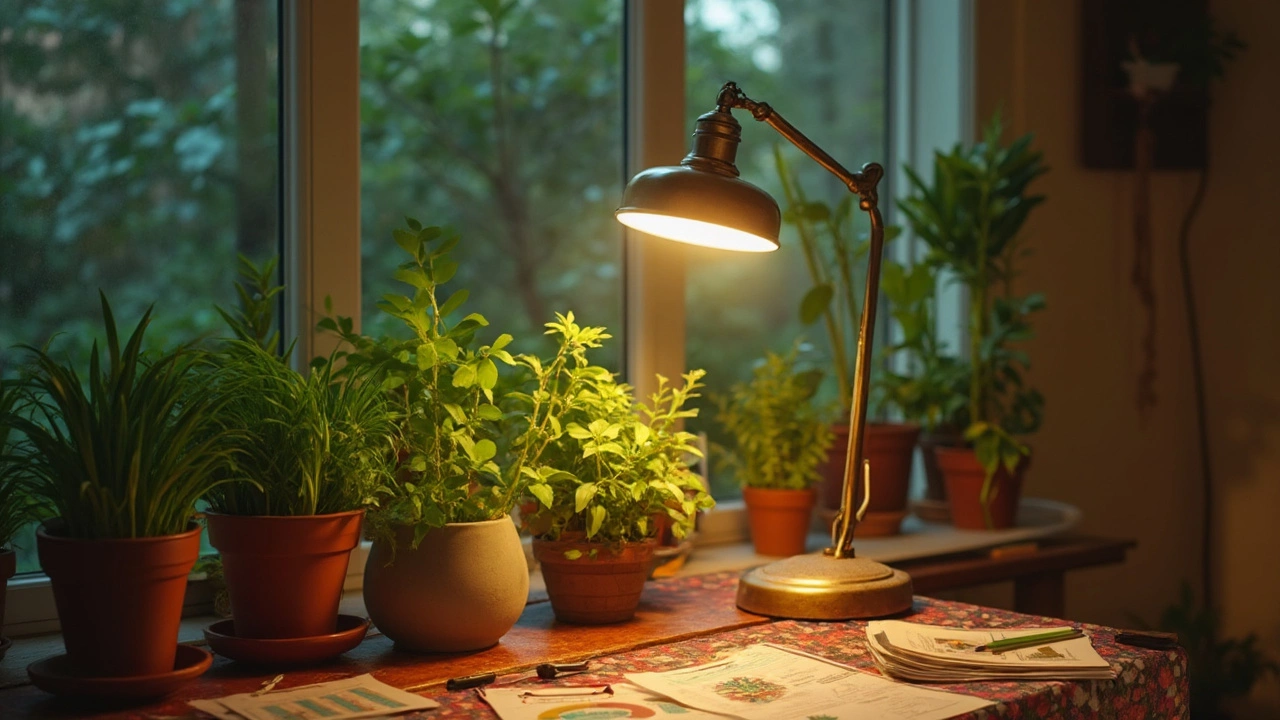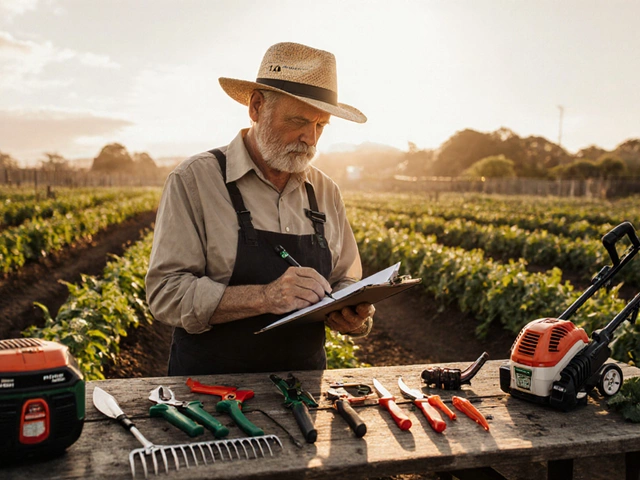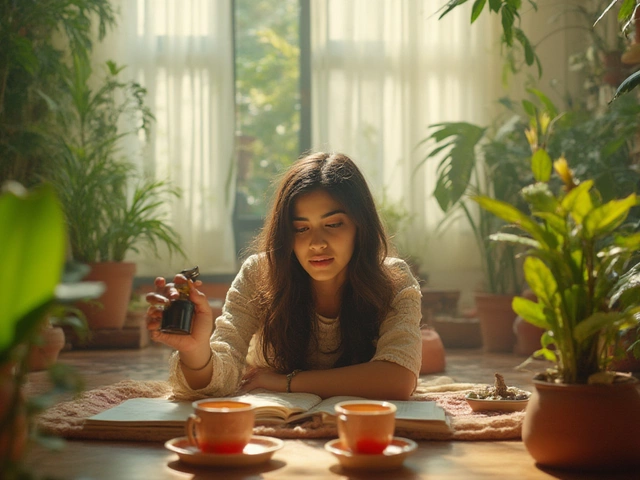Ever stared at your favorite houseplant and wondered if the old lamp on your nightstand could help it grow? A lot of people try this trick—either to pinch pennies or just because it seems convenient. You probably already guessed that plants need more than just any old light source, but how bad could it be, right?
Before you swap in a bulb and cross your fingers, let's get into what actually matters. Plants use light to make food—a process fancy folks call photosynthesis—but not all light helps them do this. Regular lamps are built for our eyes, not for hungry leaves. If you want your plants to actually thrive (or just not die), you’ll need a few key tips and a little background on what kind of light actually gets the job done indoors.
- What Plants Really Need from Light
- How Regular Lamps Measure Up
- Types of Bulbs: The Good, the Bad, and the Useless
- Practical Tips for Using Home Lamps
- Budget-Friendly Alternatives to Real Grow Lights
- Red Flags: When Lighting Isn’t Enough
What Plants Really Need from Light
If you want indoor plants to be more than sad, floppy decorations, you’ve got to give them the right kind of light. Plants aren’t just picky—they actually don’t even "see" light the way we do. They care about two things: how much light they get (intensity), and what kind of light it is (spectrum).
First big fact: most houseplants and veggies use visible light’s blue and red wavelengths for photosynthesis. Regular bulbs put out a lot of yellow and green, which do almost nothing for plants. The magic words here are “PAR” or photosynthetically active radiation—the part of light plants actually use. Sunlight covers the whole range, which is why outdoor plants always look better than the ones you forgot on your desk.
Check out this quick cheat sheet comparing light types:
| Light Source | Wavelength Coverage | Plant Usefulness |
|---|---|---|
| Sunlight | Full spectrum (all colors) | Excellent |
| LED grow light | Custom: mostly blue/red | High (designed for plants) |
| Regular incandescent | Mostly yellow/red | Low |
| Fluorescent bulb | Fairly broad, but weaker in red | Decent (okay for many houseplants) |
The second piece of the puzzle is intensity. Most houseplants want at least 1,000 lux to do more than just survive—and bright lovers (like tomatoes) need way more, sometimes up to 10,000 lux. A regular lamp barely scratches the surface here. If you see long, weak stems or pale leaves, your plant is practically waving a white flag.
Here are the basics for happy indoor plants:
- Look for light sources labeled “full spectrum” or “daylight” for best results.
- Aim that light directly at your plant—not across the room.
- Use timers or keep the lights on for 12–16 hours if you want steady growth.
Bottom line: for real plant growth, not just survival, you need the right grow light in both spectrum and intensity. Otherwise, you’ll get limp results, no matter how much you love your lamp.
How Regular Lamps Measure Up
Regular lamps aren’t designed for plants—they’re made for humans. Our eyes like warm, soft light, but your leafy buddies want something closer to the sun. Here’s the harsh truth: most standard lamps just don’t give your plants what they need to grow well.
Let’s talk about the numbers. Natural sunlight delivers about 2000 µmol/m²/s of light intensity on a sunny day. Most indoor plants do fine with just 100-500 µmol/m²/s. Now, a basic desk lamp? It usually puts out less than 50 µmol/m²/s. That’s nowhere near enough for real growth—think just barely surviving, not thriving.
The type of bulb matters. Incandescent bulbs (the old-school kind) barely offer any useful light for photosynthesis and waste a ton of energy as heat. Compact fluorescents (CFLs) and LEDs do a little better, but they’re still not made to provide the full spectrum of light that plants crave. Here’s a quick rundown comparing common bulbs for grow light use:
| Bulb Type | Light Spectrum Coverage | Light Intensity (at 12 inches) | Energy Efficiency |
|---|---|---|---|
| Incandescent | Poor | 10-17 µmol/m²/s | Low |
| CFL | Fair | 20-40 µmol/m²/s | Medium |
| Standard LED | Fair | 20-30 µmol/m²/s | High |
| Grow Light (LED/CFL) | Excellent | 100-300 µmol/m²/s | High |
See those numbers? Regular lamps and bulbs just don’t stack up compared to dedicated grow lights. Plus, while plants mostly use blue and red wavelengths, most regular bulbs pump out yellow and green—great for your eyes, useless for leaves.
Using regular lamps also means you’ll need to keep them much closer to your plants, which can burn leaves or dry out the soil. And even then, your plants might stretch out and get leggy as they reach for any light they can find.
If you’re only trying to keep an easy houseplant alive over the winter, a regular lamp in a bright room might do the trick. But if you expect anything more—like actual growth or flowering—it’s just not enough light, plain and simple.
Types of Bulbs: The Good, the Bad, and the Useless
If you’ve ever stood in the lighting aisle looking at a wall of bulbs, you know it gets confusing. All bulbs shine light, but that doesn’t mean your indoor plants love them. What your leafy friends actually want is the right spectrum of light—think of it like a balanced diet. Most regular bulbs aren’t up to the job, but some get close.
Here’s what you need to know about the common bulb types—and how well they work as a grow light:
- Incandescent bulbs: These are the old school, classic bulbs that are probably gathering dust in a junk drawer right now. Plants don’t really like them. They run hot, waste tons of energy, and mostly give off yellow and red light, missing the blue plants need for strong growth.
- CFL (Compact Fluorescent Light) bulbs: Better than incandescent, but still not ideal. They’re cooler to the touch and give off a broader light spectrum, which means your plant can actually use some of the light. You want a "daylight" or "cool white" bulb if you go this route—they shower your plant with more of the blue and white spectrum that mimics real sun.
- LED bulbs: Most promising of the bunch. If you can find a daylight-simulating LED or one that’s specifically labeled for plants, you’re in business. They’re energy efficient, come in all shapes, and barely get warm. The only catch? Some regular LEDs are too heavy on the yellow or soft-white side, so choose one that says "full spectrum."
- Halogen bulbs: Honestly, skip these for plants. They’re just incandescent bulbs with a small upgrade, still missing the mark on useful light for growth and burning a lot of juice for not a lot of green results.
If you’re into numbers, check out the color temperature and PAR (Photosynthetically Active Radiation) when you buy. Most plants love a color temperature between 5000K and 6500K, which gives off a daylight vibe.
| Bulb Type | Energy Use | Heat Output | Useful Spectrum |
|---|---|---|---|
| Incandescent | High | Very Hot | Low |
| CFL | Moderate | Warm | Medium |
| LED (Daylight/Full Spectrum) | Low | Very Low | High |
| Halogen | High | Hot | Low |
Plain truth? Most bulbs you have at home were designed to make your room comfy—not to help your pothos or basil thrive. Invest in the right kind of light and you’ll see the difference pretty fast. If you’re stuck with regular bulbs, stick as close as you can to daylight or cool white versions, keep them about 6-12 inches from your plant, and don’t expect miracles.

Practical Tips for Using Home Lamps
If you want to use a regular lamp to help your indoor plants, you’ll need to work around its limits. Not all lamps or bulbs are equal—some barely make a difference, while others can help your plants hang on until you can upgrade to a real grow light.
First, stick with the brightest bulb your lamp can safely handle. Plants love brightness, and standard 40W bulbs barely register for them. Go for LED bulbs if possible; they run cooler and put out more light per watt, so you can get closer to the leaves without frying them.
The color temperature of the bulb matters a lot. Plants respond best to bulbs labeled as "daylight" or in the 5000K to 6500K range. These mimic the part of the sunlight spectrum plants actually use for growing. Avoid "warm white"—those sit at around 2700K and help your plant grow about as much as watching Netflix helps you exercise.
Position is everything. Put the lamp close to the plant—6 to 12 inches away is usually about right. The farther away, the less usable light hits the leaves. Angle the bulb so the light falls directly on the top of the plant, not just from the side.
Keep the light on longer than you would for human comfort—12 to 16 hours a day is about the sweet spot for most houseplants. Get yourself a cheap outlet timer so you don’t have to remember to toggle the lamp every day.
- Use "daylight" LEDs at 5000K-6500K for better plant-friendly light
- Place the lamp 6-12 inches above the plant
- Leave the lamp on 12-16 hours daily
- Opt for higher wattage (as much as your lamp and bulb allow)
- Consider using a reflector (like foil or a white card) behind the lamp for an easy boost
Wondering which bulbs work best? Here’s a quick look at how common indoor bulbs stack up for growing plants:
| Bulb Type | Typical Wattage Used | Light Spectrum | Effectiveness for Plants |
|---|---|---|---|
| Standard Incandescent | 40-100W | Mostly warm, low blue | Poor |
| Compact Fluorescent (CFL) | 13-23W | Varies, get “daylight” | Fair |
| LED "Daylight" Bulb | 8-15W | 5000K-6500K | Good |
| Halogen Bulb | 35-70W | Some blue, mostly warm | Weak |
The bottom line: a grow light will always outperform a regular lamp, but with these tweaks, you can give your plants a fighting chance. If your lamp isn’t cutting it, at least you’ll know why—and how to do better without breaking the bank.
Budget-Friendly Alternatives to Real Grow Lights
Not everyone has the cash for fancy grow lights, but that doesn’t mean your plants are doomed. There are some pretty clever ways to mimic the essentials that grow light setups provide, even if your budget is tight.
First, don’t overlook compact fluorescent lamps (CFLs). You know those twisty bulbs? They’re way cheaper than most LED grow lights and can still do the job for basic houseplants. Go for daylight or cool white CFLs marked “5000K” to “6500K” on the package. This color temperature means they’re kicking out the type of blue and white light most plants crave.
LED bulbs meant for home use are another hack. If you stick with bulbs rated between 5000K and 6500K, they work in a pinch. The trick is to place them close—plants need to be within 6 to 12 inches of the bulb, or they won’t get enough light.
- Clip-on desk lamps: You can pop daylight LED bulbs into a cheap clip-on lamp and position it right above your plant. It’s flexible and works for windowsills crowded with pots.
- Shop lights: Those 4-foot-long LED shop lights at big box stores are a favorite for plant lovers on a budget. Hang them with chains or even string, and line up several plants underneath.
- Reflectors: Aluminum foil or white poster board behind your plant can bounce extra light onto the leaves, making whatever bulb you use more effective.
If you’re still using regular incandescent bulbs, swap them out. They get way too hot and don’t have enough useful light for most plants. Also, timing matters. Try using a smart plug or an old-school timer to keep your DIY setup turned on for 12–16 hours a day. That’s what most indoor plants want, even if your gear isn’t high-end.
For real penny-pinchers, cruising local thrift stores can be gold. You might find secondhand desk or floor lamps that are perfect for repurposing. Just make sure the bulb fits the color range plants need, not the soft yellow stuff you’d use to relax in your living room.
Bottom line: You don’t have to splurge to give your houseplants the light they need. With the right bulbs and a little creativity, those budget options can go a long way.
Red Flags: When Lighting Isn’t Enough
Sometimes you do everything right—pick the best spot, use your regular lamp, remember to water—and those plants just don’t look happy. The truth is, even if you try to hack it with a regular lamp, your plants will let you know when something’s off. Paying attention to these red flags early helps you save them before it’s too late.
- Grow light issues pop up fast when lighting isn’t cutting it. If your plant’s new leaves are smaller than usual or growing far apart on the stem, that’s a sign of stretching—called etiolation. They’re reaching for light that just isn’t there.
- Leaves turning pale, weak, or yellow can mean your lamp isn’t giving off enough of the blue and red spectrum that plants need. You might also spot brown edges or crispy tips—plants get stressed when their energy supply is starved.
- Slow or no growth is a big red flag. Most common houseplants pop out new leaves or stems every couple of weeks. If your plant is stuck in neutral, odds are the lighting setup isn’t up to the job.
- If you see moldy soil or leaves that fall off for no good reason, your lighting might not be drying out moisture fast enough. Too little light means water sits and invites fungus or pests.
Check out how these signs stack up in different lighting situations:
| Lighting Situation | Common Signs of Trouble |
|---|---|
| Weak, regular lamp bulb | Pale, leggy growth, yellow leaves, soil stays damp |
| Window with indirect natural light | Steady growth, leaves look normal, less risk of mold |
| High-quality LED grow light | Healthy color, compact growth, frequent new leaves |
If you spot any of these warning signs, don’t just add more water or fertilizer. Step back and look at your lighting setup—and remember, some plants really can’t thrive without the right kind of artificial light. Swapping out bulbs for actual plant lights is sometimes the only thing that’ll get your indoor jungle back on track.





